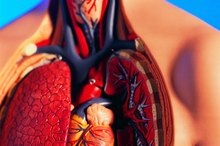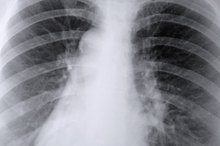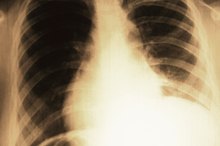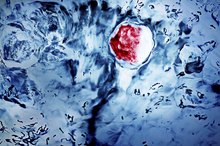What Are the Causes of Infiltration of Lungs?
Lung disorders such as pneumonia, silicosis, asbestosis and cystic fibrosis often cause the air sacs or alveoli to fill with fluids comprised of white blood cells, cancer cells, pus, proteins or blood. These substances are called infiltrates. Depending on the severity of the condition, these infiltrates can involve a small area of the lung causing minor symptoms or completely fill an entire region of the lung causing a serious, life-threatening condition.
Actinomycosis
This bacterial infection not only affects the lungs, but it can affect other parts of the body, as well. According to MedlinePlus, the lungs become severely inflamed causing differing levels of irreversible damage regardless of the treatment 1. Primary symptoms include fever and coughing with mucus production. Pus collects in the pleural space, a condition known as empyema.
- This bacterial infection not only affects the lungs, but it can affect other parts of the body, as well.
- Pus collects in the pleural space, a condition known as empyema.
Acute Respiratory Distress Syndrome
List of Acute Diseases
Learn More
Acute respiratory distress syndrome, or ARDS, is a serious illness that usually leads to respiratory failure. According to the National Heart Lung and Blood Institute, ARDS is a nonspecific disease related to severe pneumonia, shock, sepsis and trauma 2. ARDS often requires immediate medical intervention because of respiratory insufficiency. As the air sacs fill with fluid from infection, the condition severely reduces the lungs’ ability to collect and distribute oxygen to the cells. The lungs become stiff and difficult to ventilate leading to severe shortness of breath.
- Acute respiratory distress syndrome, or ARDS, is a serious illness that usually leads to respiratory failure.
- The lungs become stiff and difficult to ventilate leading to severe shortness of breath.
Pneumonia
A variety of bacteria can cause pneumonia 3. The most common cause of bacterial pneumonia is Streptococcus pneumoniae. Coughing, chest pain, and shortness of breath soon follow as the lungs’ smallest airways and alveoli become inflamed from the infection. According to the University of Maryland Medical Center, the scattered infiltrates reveal a massive influx of white blood cells that attack the invading bacteria, producing pus 3. People with this infection often cough up green or yellow mucus, sometimes streaked with blood.
Pulmonary Edema
What Are the Functions of Simple Squamous Epithelial Cells?
Learn More
Pulmonary edema is a collection of fluid in the lung tissue and alveoli because of increased pressure within the capillaries, the tiny blood vessels within the lungs, causing them to leak. According to MayoClinic.com, pulmonary edema is most often the result of heart disease and heart failure, kidney failure and hypertension 4. Pulmonary edema can also occur from inhaling toxic gases, from smoke inhalation from severe pneumonia and shock. The lungs fill with frothy, pink-tinged secretions severely limiting a person’s ability to breathe. Without treatment, people can essentially drown in their own secretions.
- Pulmonary edema is a collection of fluid in the lung tissue and alveoli because of increased pressure within the capillaries, the tiny blood vessels within the lungs, causing them to leak.
- According to MayoClinic.com, pulmonary edema is most often the result of heart disease and heart failure, kidney failure and hypertension 4.
Related Articles
References
- MedlinePlus: Actinomycosis
- National Heart Lung and Blood Institute: What is ARDS?
- University of Maryland Medical Center: Pneumonia
- MayoClinic.com: Pulmonary Edema, Definition
- Confalonieri M, Salton F, Fabiano F. Acute respiratory distress syndrome. Eur Respir Rev. 2017;26(144):160116. doi:10.1183/16000617.0116-2016
- Sweeney RM, McAuley DF. Acute respiratory distress syndrome. Lancet. 2016;388(10058):2416-2430. doi:10.1016/S0140-6736(16)00578-X
- Saguil A, Fargo M. Acute respiratory distress syndrome: diagnosis and management. Am Fam Physician. 2020;101(12):730-738.
- Máca J, Jor O, Holub M, et al. Past and present ARDS mortality rates: A systematic review. Respir Care. 2017;62(1):113-122. doi:10.4187/respcare.04716
- Papazian L, Calfee CS, Chiumello D, et al. Diagnostic workup for ARDS patients. Intensive Care Med. 2016;42(5):674-685. doi:10.1007/s00134-016-4324-5
- Marchetti N. Acute respiratory distress syndrome (ARDS). American College of Chest Physicians. Updated May 6, 2020.
- American Lung Association. ARDS symptoms and diagnosis. Updated March 24, 2020.
- Cleveland Clinic. Acute respiratory distress syndrome (ARDS): Diagnosis and tests. Updated June 20, 2020.
- National Heart, Lung, and Blood Institute. Ventilator/ventilator support.
- Peck TJ, Hibbert KA. Recent advances in the understanding and management of ARDS. F1000Res. 2019;8:F1000 Faculty Rev-1959. doi:10.12688/f1000research.20411.1
- Matthay MA, Zemans RL, Zimmerman GA, et al. Acute respiratory distress syndrome. Nat Rev Dis Primers. 2019;5(1):18. doi:10.1038/s41572-019-0069-0
- Henderson LA, Canna SW, Schulert GS, et al. On the alert for cytokine storm: immunopathology in COVID-19. Arthritis Rheumatol. 2020;72(7):1059-1063. doi:10.1002/art.41285
- So C, Ro S, Murakami M, Imai R, Jinta T. High-dose, short-term corticosteroids for ARDS caused by COVID-19: a case series. Respirol Case Rep. 2020;8(6):e00596. doi:10.1002/rcr2.596
Writer Bio
Based in Atlanta, Valerie Liles has been writing about landscape and garden design since 1980. As a registered respiratory therapist, she also has experience in family health, nutrition and pediatric and adult asthma managment. Liles holds a Bachelor of Arts in journalism from Colorado State University and a Master of Science in technical communication from the University of Colorado.









